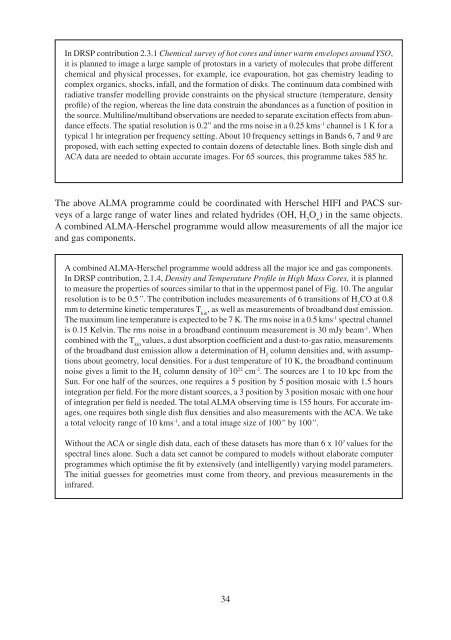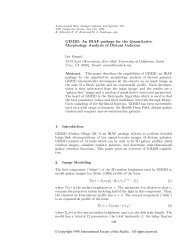4 Comparison of the ALMA and Herschel - ESO
4 Comparison of the ALMA and Herschel - ESO
4 Comparison of the ALMA and Herschel - ESO
Create successful ePaper yourself
Turn your PDF publications into a flip-book with our unique Google optimized e-Paper software.
In DRSP contribution 2.3.1 Chemical survey <strong>of</strong> hot cores <strong>and</strong> inner warm envelopes around YSO,<br />
it is planned to image a large sample <strong>of</strong> protostars in a variety <strong>of</strong> molecules that probe different<br />
chemical <strong>and</strong> physical processes, for example, ice evapouration, hot gas chemistry leading to<br />
complex organics, shocks, infall, <strong>and</strong> <strong>the</strong> formation <strong>of</strong> disks. The continuum data combined with<br />
radiative transfer modelling provide constraints on <strong>the</strong> physical structure (temperature, density<br />
pr<strong>of</strong>ile) <strong>of</strong> <strong>the</strong> region, whereas <strong>the</strong> line data constrain <strong>the</strong> abundances as a function <strong>of</strong> position in<br />
<strong>the</strong> source. Multiline/multib<strong>and</strong> observations are needed to separate excitation effects from abundance<br />
effects. The spatial resolution is 0.2” <strong>and</strong> <strong>the</strong> rms noise in a 0.25 kms -1 channel is 1 K for a<br />
typical 1 hr integration per frequency setting. About 10 frequency settings in B<strong>and</strong>s 6, 7 <strong>and</strong> 9 are<br />
proposed, with each setting expected to contain dozens <strong>of</strong> detectable lines. Both single dish <strong>and</strong><br />
ACA data are needed to obtain accurate images. For 65 sources, this programme takes 585 hr.<br />
The above <strong>ALMA</strong> programme could be coordinated with <strong>Herschel</strong> HIFI <strong>and</strong> PACS surveys<br />
<strong>of</strong> a large range <strong>of</strong> water lines <strong>and</strong> related hydrides (OH, H 3<br />
O +<br />
) in <strong>the</strong> same objects.<br />
A combined <strong>ALMA</strong>-<strong>Herschel</strong> programme would allow measurements <strong>of</strong> all <strong>the</strong> major ice<br />
<strong>and</strong> gas components.<br />
A combined <strong>ALMA</strong>-<strong>Herschel</strong> programme would address all <strong>the</strong> major ice <strong>and</strong> gas components.<br />
In DRSP contribution, 2.1.4, Density <strong>and</strong> Temperature Pr<strong>of</strong>i le in High Mass Cores, it is planned<br />
to measure <strong>the</strong> properties <strong>of</strong> sources similar to that in <strong>the</strong> uppermost panel <strong>of</strong> Fig. 10. The angular<br />
resolution is to be 0.5”. The contribution includes measurements <strong>of</strong> 6 transitions <strong>of</strong> H 2<br />
CO at 0.8<br />
mm to determine kinetic temperatures T kin<br />
, as well as measurements <strong>of</strong> broadb<strong>and</strong> dust emission.<br />
The maximum line temperature is expected to be 7 K. The rms noise in a 0.5 kms -1 spectral channel<br />
is 0.15 Kelvin. The rms noise in a broadb<strong>and</strong> continuum measurement is 30 mJy beam -1 . When<br />
combined with <strong>the</strong> T kin<br />
values, a dust absorption coefficient <strong>and</strong> a dust-to-gas ratio, measurements<br />
<strong>of</strong> <strong>the</strong> broadb<strong>and</strong> dust emission allow a determination <strong>of</strong> H 2<br />
column densities <strong>and</strong>, with assumptions<br />
about geometry, local densities. For a dust temperature <strong>of</strong> 10 K, <strong>the</strong> broadb<strong>and</strong> continuum<br />
noise gives a limit to <strong>the</strong> H 2<br />
column density <strong>of</strong> 10 22 cm -2 . The sources are 1 to 10 kpc from <strong>the</strong><br />
Sun. For one half <strong>of</strong> <strong>the</strong> sources, one requires a 5 position by 5 position mosaic with 1.5 hours<br />
integration per field. For <strong>the</strong> more distant sources, a 3 position by 3 position mosaic with one hour<br />
<strong>of</strong> integration per field is needed. The total <strong>ALMA</strong> observing time is 155 hours. For accurate images,<br />
one requires both single dish flux densities <strong>and</strong> also measurements with <strong>the</strong> ACA. We take<br />
a total velocity range <strong>of</strong> 10 kms -1 , <strong>and</strong> a total image size <strong>of</strong> 100” by 100”.<br />
Without <strong>the</strong> ACA or single dish data, each <strong>of</strong> <strong>the</strong>se datasets has more than 6 x 10 7 values for <strong>the</strong><br />
spectral lines alone. Such a data set cannot be compared to models without elaborate computer<br />
programmes which optimise <strong>the</strong> fit by extensively (<strong>and</strong> intelligently) varying model parameters.<br />
The initial guesses for geometries must come from <strong>the</strong>ory, <strong>and</strong> previous measurements in <strong>the</strong><br />
infrared.<br />
34




